| Iabet | |
|---|---|
 Iabet is depicted on the left. Next to her is Ramesses III. | |
| Major cult center | Panopolis |
| Consort | Min |
Iabet (Iabtet, Iab, Abet, Abtet, Ab) is a goddess in Egyptian mythology, counterpart of Imentet.
| Iabet | |
|---|---|
 Iabet is depicted on the left. Next to her is Ramesses III. | |
| Major cult center | Panopolis |
| Consort | Min |
Iabet (Iabtet, Iab, Abet, Abtet, Ab) is a goddess in Egyptian mythology, counterpart of Imentet.
| Part of a series on |
| Ancient Egyptian religion |
|---|
 |
Beliefs |
Practices |
Locations |
|
Texts |
Related religions |
She is a cleanser of the Sun god Ra, and goddess of the east. Her main husband is the fertility god Min. She was worshiped in Panopolis, with her husband. [1]
In the Amduat , Iabet is depicted as a woman with her arms by her sides, under the name of Iab. Along with eleven other goddesses, including Isis and her grandmother Tefnut, the group was known as "Those who give praises to Ra as he passes over Wernes".
One princess – Nefertiabet – is named after this goddess. Her father was Pharaoh Khufu. [2]

Isis was a major goddess in ancient Egyptian religion whose worship spread throughout the Greco-Roman world. Isis was first mentioned in the Old Kingdom as one of the main characters of the Osiris myth, in which she resurrects her slain husband, the divine king Osiris, and produces and protects his heir, Horus. She was believed to help the dead enter the afterlife as she had helped Osiris, and she was considered the divine mother of the pharaoh, who was likened to Horus. Her maternal aid was invoked in healing spells to benefit ordinary people. Originally, she played a limited role in royal rituals and temple rites, although she was more prominent in funerary practices and magical texts. She was usually portrayed in art as a human woman wearing a throne-like hieroglyph on her head. During the New Kingdom, as she took on traits that originally belonged to Hathor, the preeminent goddess of earlier times, Isis was portrayed wearing Hathor's headdress: a sun disk between the horns of a cow.

Nut, also known by various other transcriptions, is the goddess of the sky, stars, cosmos, mothers, astronomy, and the universe in the ancient Egyptian religion. She was seen as a star-covered nude woman arching over the Earth, or as a cow. She was depicted wearing the water-pot sign (nw) that identifies her.
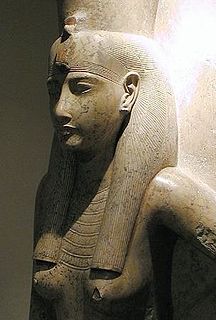
Mut, also known as Maut and Mout, was a mother goddess worshipped in ancient Egypt. Her name literally means mother in the ancient Egyptian language. Mut had many different aspects and attributes that changed and evolved a lot over the thousands of years of ancient Egyptian culture.
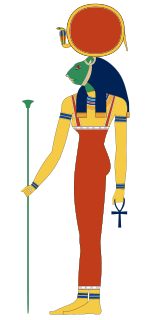
In Egyptian mythology, Sekhmet, also spelled Sakhmet, Sekhet, or Sakhet, among other spellings), is a warrior goddess as well as goddess of healing. She is depicted as a lioness. She was seen as the protector of the pharaohs and led them in warfare. Upon death, Sekhmet continued to protect them, bearing them to the afterlife.

Bastet or Bast was a goddess of ancient Egyptian religion, worshiped as early as the Second Dynasty. Her name also is rendered as B'sst, Baast, Ubaste, and Baset. In ancient Greek religion, she was known as Ailuros.

Neith was an early ancient Egyptian deity who was said to be the first and the prime creator. She was said to be the creator of the universe and all it contains, and she governs how it functions. She was the goddess of wisdom, weaving, the cosmos, mothers, rivers, water, childbirth, hunting, war, and fate.
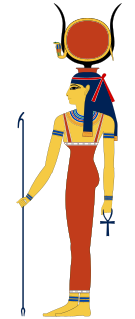
Hathor was a major goddess in ancient Egyptian religion who played a wide variety of roles. As a sky deity, she was the mother or consort of the sky god Horus and the sun god Ra, both of whom were connected with kingship, and thus she was the symbolic mother of their earthly representatives, the pharaohs. She was one of several goddesses who acted as the Eye of Ra, Ra's feminine counterpart, and in this form she had a vengeful aspect that protected him from his enemies. Her beneficent side represented music, dance, joy, love, sexuality and maternal care, and she acted as the consort of several male deities and the mother of their sons. These two aspects of the goddess exemplified the Egyptian conception of femininity. Hathor crossed boundaries between worlds, helping deceased souls in the transition to the afterlife.
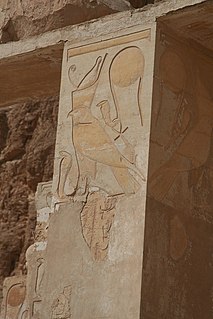
Wadjet, known to the Greek world as Uto or Buto among other names including Wedjat, Uadjet, and Udjo, was originally the ancient local goddess of the city of Dep. It became part of the city that the Egyptians named Per-Wadjet "House of Wadjet" and the Greeks called Buto, which was an important site in prehistoric Egypt and the cultural developments of the Paleolithic.

Satis, also known by numerous related names, was an Upper Egyptian goddess who, along with Khnum and Anuket, formed part of the Elephantine Triad. A protective deity of Egypt's southern border with Nubia, she came to personify the former annual flooding of the Nile and to serve as a war, hunting, and fertility goddess.

Anuket was the ancient Egyptian goddess of the cataracts of the Nile and Lower Nubia in general, worshipped especially at Elephantine near the First Cataract.

Mehet-Weret or Mehturt is an ancient Egyptian deity of the sky in ancient Egyptian religion. Her name means "Great Flood".
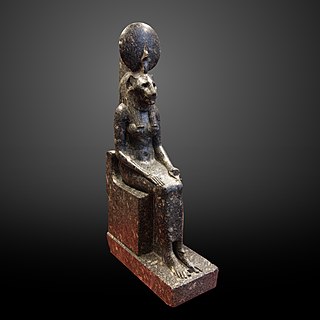
Unut, alt. Wenut or Wenet, is a prehistoric Egyptian snake goddess.

The Eye of Ra or Eye of Re is a being in ancient Egyptian mythology that functions as a feminine counterpart to the sun god Ra and a violent force that subdues his enemies. The Eye is an extension of Ra's power, equated with the disk of the sun, but it also behaves as an independent entity, which can be personified by a wide variety of Egyptian goddesses, including Hathor, Sekhmet, Bastet, Wadjet, and Mut. The Eye goddess acts as mother, sibling, consort, and daughter of the sun god. She is his partner in the creative cycle in which he begets the renewed form of himself that is born at dawn. The Eye's violent aspect defends Ra against the agents of disorder that threaten his rule. This dangerous aspect of the Eye goddess is often represented by a lioness or by the uraeus, or cobra, a symbol of protection and royal authority. The Eye of Ra is similar to the Eye of Horus, which belongs to a different god, Horus, but represents many of the same concepts. The disastrous effects when the Eye goddess rampages out of control and the efforts of the gods to return her to a benign state are a prominent motif in Egyptian mythology.

Anput is a goddess in ancient Egyptian religion. Her name is written in hieroglyphs as jnpwt. In English, her name is also rendered Anupet, Input, Inpewt and Yineput. As the female version of her husband Anubis, who was known as jnpw to the Egyptians, Anput's name ends in a feminine "t" suffix. She is the goddess of funerals and mummification, as well as the mother of Kebechet and possibly Ammit.

Nuit is a goddess in Thelema, the speaker in the first Chapter of The Book of the Law, the sacred text written or received in 1904 by Aleister Crowley.
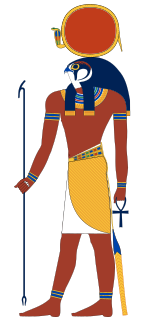
Ra or Re is the ancient Egyptian deity of the sun. By the Fifth Dynasty in the 25th and 24th centuries BC, he had become one of the most important gods in ancient Egyptian religion, identified primarily with the noon sun. Ra was believed to rule in all parts of the created world: the sky, the Earth, and the underworld. He was the god of the sun, order, kings, and the sky.
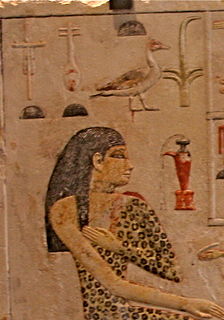
The Egyptian hieroglyph Emblem of the East is a portrayal of a standard, surmounted by the "Symbol of the East". It represents the Goddess Iabet. Her companion goddess Imentet is represented by the "Emblem of the West". As an ideogram, it represents either iꜣbt "east" or iꜣby "left". The symbol for the "West"/"right" was considered 'good', and thus the East symbol sometimes symbolized the opposite of good, evil. However, as the sun rises in the East, the solar cult often used the symbol.
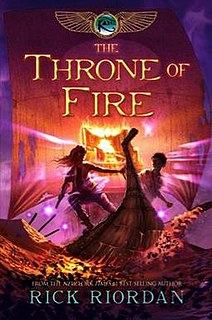
The Throne of Fire is a 2011 fantasy adventure novel written by American author Rick Riordan. It is the second novel in The Kane Chronicles series, which tells of the adventures of modern-day fourteen-year-old Carter Kane and his twelve-year-old sister - Sadie Kane, as they discover that they are descended from the ancient Egyptian pharaohs Narmer and Ramesses the Great. It was released on May 3, 2011. The book takes place roughly three months after the first book, The Red Pyramid. It is followed by the third and final book in the series, The Serpent's Shadow, which was released on May 1, 2012.

Mehit or Mehyt was an Ancient Egyptian goddess. In the Early Dynastic period she was depicted as a reclining lioness with three bent poles projecting from her back. In that era she appears in numerous early dynastic sealings and ivory artifacts, usually together with a representation of an Upper Egyptian shrine. Her main places of worship were Hierakonpolis and Thinis.